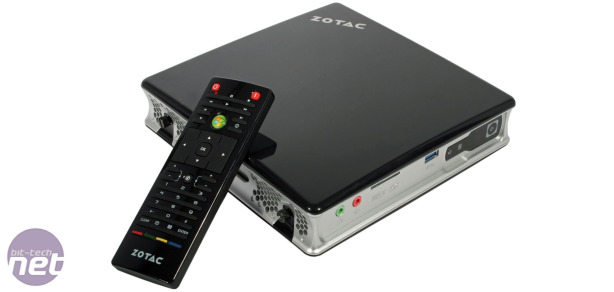
Performance Analysis
With its low power hardware and slow spinning hard drive, we were hardly expecting the ID42 Plus to tear through our benchmark suite, and indeed it chugged through them at a rather slow pace. It performed most favourably in the CPU intensive video encoding task, and was worst in the multi-tasking test with a score of just 416. Its overall score of 513 means it's around half as fast as our reference PC, which was put through its paces now nearly six years ago.Such demanding tasks as our benchmarks run are unlikely to ever be of much concern to anyone with an interest in the ID42 Plus, however. Instead, media playback would be its primary use, so we were keen to see what it could do in this arena too. Throwing some encoded 1080p movie trailers resulted in silky smooth playback, so we upped the challenge and tasked it with playing an uncompressed Blu Ray ISO, which it also handled with seeming ease. Finally, flash performance on iPlayer HD and YouTube 1080p showed occasionally noticeable performance dips but was fine overall.
Though the low end Nvidia GPU seems easily capable of playing HD content, it understandably has somewhat limited capabilities when it comes to games. It seems to suffer most heavily from anti-aliasing being active, as Skyrim was only playable with it set to zero (the 18fps minimum is a result of small stutters as the overall experience was playable enough here). It copes with the Source Engine in Left 4 Dead 2 well enough, again likely due to the lack of AA, and reducing some settings from high would easily net you playable frame rates at 1,680 x 1,050.
To stress the cooling system of the ID42 Plus, we ran a small fft test in Prime95 alongside an instance of the Unigine Heaven 3.0 graphics benchmark for fifteen minutes, thus placing full load on both the CPU and GPU. Recording temperatures with Core Temp and GPU-Z, the CPU peaked at 64°C and the GPU at 61°C in a room with an ambient temperature of 21°C. These temperatures are perfectly healthy, and well within the maximum specified temperatures of the two chips, so overheating won't be an issue with the ID42 Plus. We also noted that in this unrealistic, fully loaded scenario, the total system power draw was just 59W, compared to 32W when idling at the desktop.
Even more pleasing was the fact that the fan on the Zbox remained nice and quiet, even throughout our demanding thermal stress test. Noise is a major issue to consider when buying a system primarily designed for media playback, so while this is a positive, there's a major drawback too. With the system off but the power supply connected, the ID42 Plus emits an annoying high pitched whine, suggesting that Zotac has cut corners with its power circuitry. It becomes louder with the system on and isn't helped by the noise of the mechanical hard disk. It's not overly loud, but the pitch was irritating even to us in our somewhat noisy labs.
Conclusion
We want to like the Zbox ID42 Plus, as it does almost everything it's designed to do rather well. Its design means it would look at home underneath most modern flatscreens, and its impressive array of connections and smooth HD video playback makes it well suited to this task too. It's not slow in general desktop usage either and would handle some casual gaming too, albeit with the settings lowered somewhat. We'd probably opt for the ID42 barebones package ourselves, giving us some spare cash to choose our own memory and hard drive, but Zotac's choices are good value too. The annoying noise from the power circuitry is a real shame, therefore, as in all honesty it would put us off using the system at home.-
Performance16 / 25
-
Features22 / 25
-
Design18 / 25
-
Value20 / 25


MSI MPG Velox 100R Chassis Review
October 14 2021 | 15:04










Want to comment? Please log in.